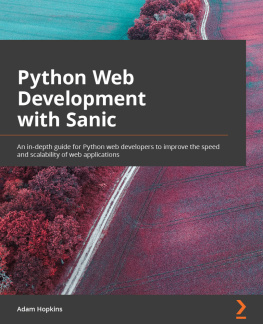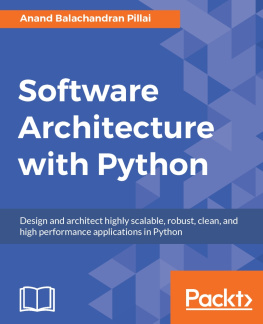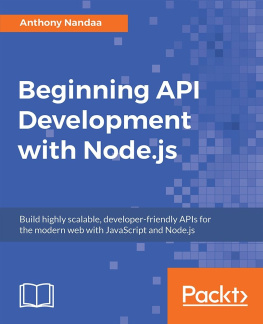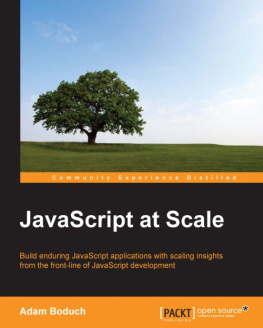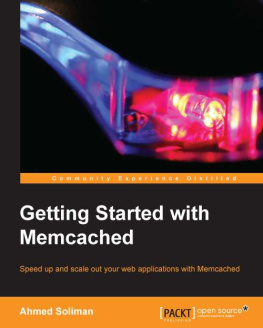Adam Hopkins - Python Web Development with Sanic: An in-depth guide for Python web developers to improve the speed and scalability of web applications
Here you can read online Adam Hopkins - Python Web Development with Sanic: An in-depth guide for Python web developers to improve the speed and scalability of web applications full text of the book (entire story) in english for free. Download pdf and epub, get meaning, cover and reviews about this ebook. year: 2022, publisher: Packt Publishing - ebooks Account, genre: Romance novel. Description of the work, (preface) as well as reviews are available. Best literature library LitArk.com created for fans of good reading and offers a wide selection of genres:
Romance novel
Science fiction
Adventure
Detective
Science
History
Home and family
Prose
Art
Politics
Computer
Non-fiction
Religion
Business
Children
Humor
Choose a favorite category and find really read worthwhile books. Enjoy immersion in the world of imagination, feel the emotions of the characters or learn something new for yourself, make an fascinating discovery.
- Book:Python Web Development with Sanic: An in-depth guide for Python web developers to improve the speed and scalability of web applications
- Author:
- Publisher:Packt Publishing - ebooks Account
- Genre:
- Year:2022
- Rating:3 / 5
- Favourites:Add to favourites
- Your mark:
Python Web Development with Sanic: An in-depth guide for Python web developers to improve the speed and scalability of web applications: summary, description and annotation
We offer to read an annotation, description, summary or preface (depends on what the author of the book "Python Web Development with Sanic: An in-depth guide for Python web developers to improve the speed and scalability of web applications" wrote himself). If you haven't found the necessary information about the book — write in the comments, we will try to find it.
Follow along with author Adam Hopkins and build a performant and scalable web application using Sanic, along with maintaining clean code to fit your unique challenges and business requirements
Key Features- Use the power of Sanic to build a scalable and high-performant web application
- Analyze and implement Sanic in common use cases
- Create a complete web application from scratch using the latest features of the Sanic framework
Todays developers need something more powerful and customizable when it comes to web app development. They want the tools to build something, and not simply glue a bunch of things together built by others. This is where Sanic comes into the picture. Its a next-generation Python framework and server tuned for high performance and built to be unopinionated and scalable.
Youll start by understanding Sanics purpose, significance, and use cases. Next, youll learn to spot different issues when building web applications, and how to choose, create, and adapt the right solution to meet your needs. As you progress, youll understand how to use listeners, middleware, and background tasks to customize your application. The book will take you through real-world examples, so you walk away with practical knowledge and not just code snippets.
By the end of this web development book, you will have gained the knowledge you need to design, build, and deploy high-performance, scalable, and maintainable web applications with the Sanic framework.
What you will learn- Strengthen your knowledge of web application architecture
- Explore the difference between WSGI, Async, and ASGI servers
- Understand the core philosophies of performance, scalability, and unopinionated
- Focus on how Sanic organizes incoming data, why it does it, and how to make the most of it
- Implement best practices for reliable, performant, and secure web apps
- Understand useful techniques for successfully deploying a Sanic web app
- Create an effective custom task manager within Sanic
- Discover security concerns and how to deal with them in your Sanic apps
This book is for Python web developers who have knowledge of how web technologies work and are looking to enhance their skills by taking their applications to the next level using the power of the Sanic framework. Working knowledge of Django and/or Flask is required. A basic to intermediate-level understanding of Python 3, HTTP, RESTful API patterns, and modern development practices and tools, such as type annotations, pytest, and virtual environments is also assumed.
Table of Contents- An Introduction to Sanic and Async Frameworks
- Organizing a Project
- Routing and Intaking HTTP Requests
- Ingesting HTTP Data
- Handling and Responding Views
- Outside the Response Cycle
- Dealing with Security Concerns
- Running a Server
- Best Practices to Improve Your Web Applications
- Implementing Sanic in Common Use Cases
- A Complete Real-World Example
Adam Hopkins: author's other books
Who wrote Python Web Development with Sanic: An in-depth guide for Python web developers to improve the speed and scalability of web applications? Find out the surname, the name of the author of the book and a list of all author's works by series.

